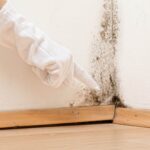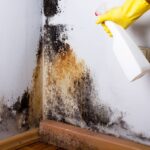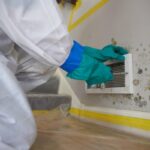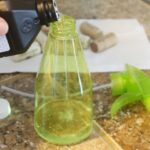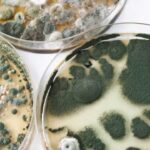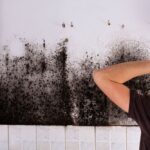Mold is a common problem in many households, and it can be a health hazard if not dealt with properly. While there are many mold removers available on the market, some of them contain harmful chemicals that can be dangerous to use.
Fortunately, there are non-toxic mold removers that are safe and effective. In this article, we will discuss the benefits of using non-toxic mold removers and provide some recommendations for products to try.
Mold removal can be tricky and it’s often best to enlist the help of a professional. However, there are some safe, DIY non-toxic mold removal methods that work well if you know what you’re doing.
1. Use bleach
One way to get rid of mold is to use bleach in conjunction with ventilation and protection from sunlight or rain. Dilute 1 cup of bleach per gallon of water, spray the moldy area liberally, then wait 10 minutes before scrubbing with a mild detergent and water; repeat as necessary.
Bleach will kill spores on surfaces too so make sure everything is clean before moving on.
2. Use baking soda
Another mold removal method is to use baking soda. Wet the area where the mold growth is occurring, sprinkle baking soda over the surface and scrub with a stiff brush or your hands until all of the mold is gone.
Baking soda also helps prevent spores from growing in future occurrences so be sure to scrub it off completely afterwards!
3. Use vinegar
Vinegar can also help remove mold and mildew by providing moisture and killing spores. Mix 2 cups of vinegar with 1 gallon of water in a spray bottle, mist the area where the mold is growing and scrub with a brush.
Be sure to rinse off the area thoroughly afterwards to avoid any vinegar smell or stains.
4. Use hydrogen peroxide
Hydrogen peroxide can be used as both a cleaning solution and mold killer. Mix 1/2 cup of hydrogen peroxide with 1 gallon of water in a spray bottle, spritz the moldy area liberally, then scrub with a brush. Wipe down any areas that stain or remove residual bleach odor with water before moving on.
5. Use a vacuum cleaner
If mold growth is extensive or affected areas are hard to reach, you can try using a vacuum cleaner to remove the mold spores.Attach the hose to the machine and turn it on to its highest possible setting, then move around the area cleaning up as needed.
Be sure to wear goggles and protective gloves in order for prevent any eye damage from mold spores!
Hopefully one of these mold removal methods will be effective in removing the growth on your surface. Remember to always clean any affected surfaces before moving on to prevent future occurrences!
Cleaning Tips – Safely remove mold yourself with a cautious approach.
Tips for safely removing mold from surfaces in your home.
- Always wear gloves when cleaning moldy areas.
- Use a mold removal cleaner specific to the type of mold growing in your environment.
- Dry the area thoroughly before returning any furniture or objects back into place.
- Avoid using bleach or other harsh cleaning products on moldy surfaces
- Take care when moving moldy material: Mold spores are easily airborne, so be careful not to breathe in any mold while cleaning. If the moldy material is too heavy or awkwardly situated to move with your hands, use a broom and dustpan instead.
- Use ventilation and safety precautions: Work in a well-ventilated area; wear goggles and protective gloves if necessary; avoid using high-powered tools or opened flame; let the area dry completely before returning any furniture or other objects back into place.
- Scrub mould off surfaces until it disappears : Apply a strong scrubbing agent to moldy surfaces such as wood, tiles, or scaling paint. Scrub until the mold is gone. Rinse with water and dry off the area thoroughly before returning any furniture or other objects back into place.
- Call a professional: If none of these methods works, call an expert to remove the mold from your surface.
Dealing with mold can be a daunting task, but it’s important to take it seriously for the health and safety of your household. N
on-toxic mold removers can be a safe and effective way to remove mold without the harmful side effects of traditional mold removers. With so many options available, it’s important to do your research and choose a product that fits your needs.
By taking the necessary steps to prevent and remove mold, you can ensure a safe and healthy environment for you and your family.
FAQ Mold Removal
What is the best homemade mold remover?
There are a number of homemade mold removal agents that can be used to clean moldy areas. Some options include grapefruit seed extract, lemon juice, and white vinegar.
It is important to use a mold removal cleaner specific to the type of mold growing in your environment, as bleach or other harsh cleaning products may destroy the spores responsible for causing the Mold problem in the first place.
Is bleach or vinegar better to kill mold?
There is no definitive answer to this question. bleach and vinegar can both be effective mold removal agents, but each has its own set of hazards. Bleach can damage surfaces if it is not used correctly, while vinegar may cause damage to wood furniture if it is used in high concentrations.
It important to use a mold removal cleaner specific to the type of mold growing in your environment and dry the area thoroughly before returning any furniture or objects back into place.
Can you safely remove mold yourself?
There is no guarantee that cleaning mold yourself will be safe, but it can be an effective way to remove the problem area. Always wear gloves and use a mold removal cleaner specific to the type of mold growing in your environment. If you find that bleach or vinegar are not working well on your own, it may be best to call in a professional remediation crew.
What kills mold instantly?
Mold cannot be killed by cleaning products on their own. In fact, bleach and vinegar may actually promote the growth of mold spores in moist environments. The only way to kill mold instantly is to blast it with a high-pressure water spray or use a mold remediation agent that contains bleach or vinegar as one component.
What do professionals use to kill mold?
Professionals use mold remediation agents that contain bleach or vinegar as one component. These products are effective and safe, but it is important to be aware of the potential hazards. Mold removal can be a daunting task, but with the right mold removal cleaning products and procedures, it is possible to remove the problem area without any damage. Be sure to use caution when cleaning mold yourself and call in a professional if you have any questions or concerns.
References:
- https://b-air.com/2018/12/do-it-yourself-mold-remediation/
- https://www.thespruce.com/mold-remover-1388734
- https://www.moneypit.com/diy-mold-removal/
- https://www.quora.com/What-do-professionals-use-to-kill-mold?top_ans=177473730

